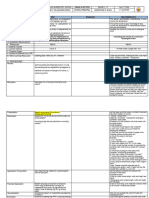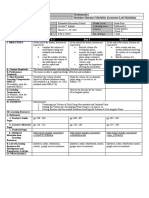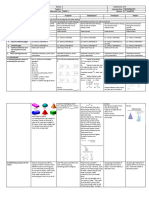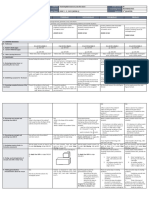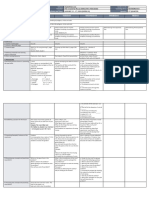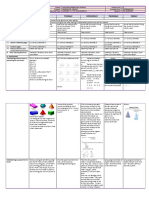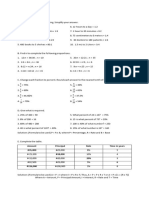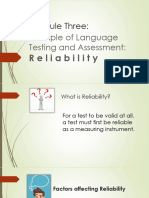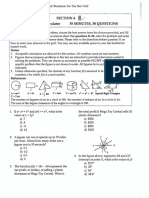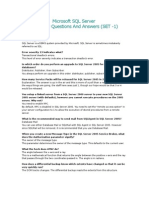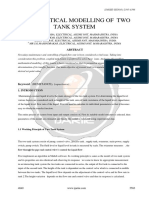DLL - Mathematics 5 - Q4 - W3
DLL - Mathematics 5 - Q4 - W3
Uploaded by
Luis SalengaCopyright:
Available Formats
DLL - Mathematics 5 - Q4 - W3
DLL - Mathematics 5 - Q4 - W3
Uploaded by
Luis SalengaOriginal Description:
Original Title
Copyright
Available Formats
Share this document
Did you find this document useful?
Is this content inappropriate?
Copyright:
Available Formats
DLL - Mathematics 5 - Q4 - W3
DLL - Mathematics 5 - Q4 - W3
Uploaded by
Luis SalengaCopyright:
Available Formats
School: Paranaque Elementary School Central Grade Level: V
GRADES 1 to 12 Teacher: LUIS V. SALENGA Learning Area: MATHEMATICS
DAILY LESSON LOG Teaching Dates and Time: March 11- 15, 2019 Quarter: 4TH QUARTER
MONDAY TUESDAY WEDNESDAY THURSDAY FRIDAY
I. OBJECTIVES
A. Content Standards demonstrates understanding of area, volume and temperature.
B. Performance Standards is able to apply knowledge of area, volume and temperature in mathematical problems and real-life situations.
C. Learning Competencies/Objectives a.Visualize the Volume of a Cube and .Name the unit of measure for measuring the volume of cube and rectangular a.Derive a formula for finding the volume of a cube and a rectangular
Write the LC code for each Rectangular Prism prism. prism using cubic centimeter and meter.
- M5ME-IVc-77 /Page 64 of 109 b.Write the value of measuring accurately b.Appreciation of application of volume in daily life situations.
- M5ME-IVc-78/ Page 64 of 109 M5ME-IVc-79
II. CONTENT Visualizes the Volume of a Cube and Names the Appropriate Unit of Measure Used for Measuring the Volume of a Derives the Formula in Finding the Volume of a Cube and A Rectangular
Rectangular Prism Cube and a Rectangular Prism. Prism Using Cubic Centimeter and Cubic Meter
III. LEARNING RESOURCES
A. References
1. Teacher’s Guide pages K to 12 Grade 5 Curriculum K to 12 Grade 5 Curriculum K to 12 Grade 5 Curriculum
2. Learner’s Material pages TM Math Grade 4 pages 298 - 307 LM Math Grade 5 pages 1 to 3
3. Textbook pages
4. Additional Materials from Learning https://en.wikipedia.org/wiki/
Resource (LR) portal Volume
B. Other Learning Resources cubes (big and small), rectangular flash cards (mm, cm, dm, m, etc.), real objects, pictures flash cards containing questions on finding area of parallelogram
prism, ruler, flash cards, marbles, (square, rectangle, rhombus, parallelogram)
worksheet, 1 transparent rectangular
container
IV. PROCEDURES
A. Reviewing previous lesson or 1.Drill 1.Drill 1.Drill
presenting the new lesson Have a drill on the multiplication facts Drill on Choosing the Appropriate Unit of Measure
using the activity sheets. Game: “Korek Ka Ba Dyan?” Mental computation/drill on finding the area or missing side of a
1) 5x5 Materials: flash cards (mm, cm, dm, m, etc.), real objects, pictures parallelogram
6) 7 x 7 Mechanics:
2) 9 x 11 a. Pupils will be grouped into 4. Each group will have flashcards (mm,
Materials: flash cards containing questions on finding area of
7) 11 x 11 cm, m, etc.)
parallelogram (square, rectangle, rhombus, parallelogram)
3) 10 x 12 b. Teacher will ask, “What unit of measure will you use?”
8) 9 x 12 Ex.: Teacher will show a pencil.
4) 4x4 c. Pupils in the group will flash their answer. (Ex. cm) Finding the missing side on the given area
9) 8 x 5 d. Teacher announces the correct answer. Repeat the process. Teacher will Mechanics:
5) 6x8 show another object or picture. a. Divide the class into 3 groups. Have members of the group count off.
10) 4 x 12 e. Group with the most number of correct answers is the winner. Pupils remember their #s in the team.
2.Review b. Teacher shows card to pupils for 10 seconds or depending on the
Have a review on the meaning of level of difficulty of questions.
2.Review
volume. What is difference between cube and rectangular prism?
Volume is the amount of space What are the dimensions of cube and rectangular prism?
occupied by any quantity.
1) A=?
4 cm
5cm
3) A=?
8cm 6 cm
2) L?
4) Rectangle:
Width 2 cm,
Area 10 cm2
L=?
5) Square A = 1 unit2, S = ?
c. Teacher calls out a number randomly. The three pupils having that
number stand up and call out the answer with correct units. The pupil
who gives the correct answer first gets the point for the team.
d. Teacher may do drawings first before shifting to pure
numerical problems. Teacher may also include finding area of
trapezoids making sure that the dimensions can be solved
mentally.
2.Review
Memory Game
Materials: pocket chart, flash cards
Mechanics:
a. Teacher prepares flash cards with figure and dimensions on a set of
cards and the corresponding area of the figure on another set of cards.
Teacher then place the shuffled cards into pocket chart slots. At the
back of each card, label them with letters.
Ex. front back
b. Divide class into 3 groups.
c. Have a member of group 1 choose 2 letters corresponding to 2 cards.
Teacher turns over the cards. If the cards match (figure and its area),
then the team gets the point and the cards taken out of the pocket
chart. If the cards do not match, then the cards are turned over again in
the same place/position in the pocket chart.
d. Have a member of group 2 call out another pair of cards. Continue
the game until all the cards have been used up. Team with the most
number of points wins.
e. Teacher may divide set of cards into a) finding area of parallelograms
and trapezoid making sure that the dimensions given are manageable
by the pupils, or b) finding the missing side/dimension given the area.
B. Establishing a purpose for the lesson 3.Motivation 3.Motivation 3.Motivation
Show a transparent cube and Richard has a rectangular box with sand inside. He wants to know the amount Show a transparent plastic container filled with balls. Ask pupils to
rectangular prism filled with marbles. of space the sand occupied. He wants to know also what unit of measure he guess the number of balls inside the container. Let a volunteer count
Ask pupils to guess the number of will use. Elicit the value of accuracy. the balls to find out the answer. Elicit from them how they can make a
marbles inside the cube and Original File Submitted and Formatted by DepEd Club Member - visit good guess of the total number of balls. Relate this to the concept of
rectangular prism. Let a volunteer depedclub.com for more volume.
count the marbles to find out the
answer. Elicit from them how they
can make a good guess of the total
number of marbles. Instill the value
of patience and orderliness. Relate
this to the concept of volume.
C. Presenting examples/instances of the Tell the class that the number of 1.Presentation Let a pupil fill a rectangular box with cubes. For purposes of having
new lesson small cubes that make up the Rubik’s A.Present a rectangular box with sand inside. exact measurements and no half-cubes, it is ideal that teacher prepares
cube is its volume. boxes/ rectangular prisms that have corresponding measurements as
the cubes that are going to be used in the activity.
D. Discussing new concepts and . Activity – Group Work Ask the following questions: Ask the pupils the following questions:
practicing new skills #1 Materials: worksheet, 1 transparent a. How can we be able to measure the capacity of the box? a. How many cubes did it take to fill the prism? How many cubic units is
rectangular container, small cubes b. What will you use? What do you think are we looking for? the length? The width? The height?
Procedure: Fill the container with c. What unit of measure will you use? b. What similar situations require you to fill up a solid such as the
small cubes until its upper portion. The volume of a solid is the amount of space the solid occupies. Volume is rectangular prism?
Example measured in cubic units. One way to find the volume of a rectangular prism is c. Define these situations as finding the volume of solids. Define volume
to multiply the 3 dimensions: as the number of cubic units (unit cubes) used to fill up a space.
Volume = length x width x height Use correct unit of measure.
d. Using this definition, ask the pupils the volume of the rectangular
Ask the pupils to measure the 3 dimensions of some objects inside the room prism.
Guide Questions: using cm3 and m3. e. Ask: Without actually counting the number of unit cubes in the solid
1) What kind of solid figure is the 1 liter = 1 dm3 how can you find its volume? What formula can we use to find the
container? number of cubic units in it or the volume of the rectangular
2) How many cubes did you put inside prism?
B.Teacher shows a cube (box) filled with blocks 2 cm on each side. Ask a pupil
the rectangular container? f. Elicit from the pupils that
to get one block and describe it.
3) How can you find the number of → To find the volume of an object means to find the number
What can you say about the block?
cubes in the container without of cubic units it contains or holds
What are the dimensions?
counting them all? g. Lead them to state the formula for the volume of a rectangular prism
A cube is a special type of rectangular prism having equal edges. Empty the
a) Count the cubes in one layer. as
box then let the pupils fill the box with the number of cubes. The total number
V = l x w x h.
of cubes that will fill the box represents the volume of the box.
h. Define volume as the number of unit cubes in the solid figure.
When finding volume, the units of volume are cubic units.
Mention the correct label (cubic units).
What are the units of volume? (cubic millimeters – mm3, cubic centimeters –
Example i. Using this definition, ask the pupils the volume of the cube.
cm3, cubic decimeter – dm3, cubic meters – m3, etc.)
4 x 2 = 8 cubes j. Ask: Without actually counting the number of unit cubes, how can you
b) Count the layers. Ex.: 3 layers find the volume of the cube? What formula can we use to find the
c) How many cubes in all? 8 x 3 = 24 number of cubic units in it?
cubes k. Try to elicit from the pupils that to find the volume of a cube, the
length of its side is multiplied by itself three times.
4) When we get the total number of l. Lead them to state the formula for the volume of a cube as
cubes that the container has, what V = S x S x S or V = S³
have we looked for? (Answer: m. Let pupils apply the rule by actually measuring and finding the
Volume) volume of some rectangular prisms and cube inside the room.
5) What kind of polygon is the base of n. Present situations like how much water does it take to fill the
the container? What are its aquarium, how far does it take to run around the park, etc. and
dimensions? distinguish perimeter/ circumference from area and volume. Elicit
6) How many cubes fit the length? similar applications of volume in daily life situations.
the width?
7) What other dimension does the
rectangular container have? How
many cubes fit the height?
8) Can you give the volume of the
rectangular prism by just using the
dimensions (length, width, height)?
How?
(Note: Teacher must tell the pupils
that by multiplying the length x width
x height will give the volume thus,
Volume = L x W x H))
E. Discussing new concepts and Group the pupils into 4 working 2. Performing the Activities 2. Performing the Activities
practicing new skills #2 teams and have them perform the Group the class into four. Let them perform the give activity. Group the pupils into 4 working teams and have them perform the task.
task. Give the appropriate unit of measure to be used in finding Find the Volume write the Given, Formula and Answer
Activity 1. They need small cubes, big the volume of Refer to LM
cubes and rectangular prism. (Select from the given choices: mm3, cm3, dm3, m3) :
Refer to LM a) room _______
b) shoe box _______
If each is a cubic unit, how c) globe _______
many cubic units are in the figures? d) refrigerator _______
How many cubic units are there in e) ice cream cone _______
one row? f) baseball _______
How many cubic units are there in
one layer?
How many layers are there?
What have you notice in the number
of layers and rows of cube and prism?
What can you say about the number
of layers and rows of a cube?
What have you notice in the length,
width and height of a cube?
What can you say about the number
of layers and rows of a prism?
What have you notice in the length,
width and height of a prism?
a.Have pupils count the number of
cubes in the figures.
b. Define volume as the
number of unit cubes in the solid
figure. Mention the correct label
(cubic units)
c.Have them imagine filling up the
classroom with such cubes. Then we
find the volume of the classroom.
Elicit similar application of volume in
daily situations.
=
F. Developing mastery 3.Processing the Activities 3.Processing the Activities 3.Processing the Activities
(Leads to Formative Assessment 3) Ask the groups to present and discuss Ask the groups to present and discuss their answers on the board. Ask the groups to present and discuss their answers on the board.
their answers on the board. Expected answer: Expected answer:
Expected answer: a) room m3 1. Given:L = 6 cm W = 10 cm
•Cube is a solid whose length, width b) shoe box cm3 H = 12 cm Answer : V = 23 100 cm3
and height are equal. c) globe cm3 2. Given:L = 25 cm W = 3 cm H = 7 cm
• Rectangular prism whose d) refrigerator dm3 Answer : V = 525 cm3
length, width and height are not e) ice cream cone cm3 3. Given:S = 9 cm Answer : V = 729 m3
equal f) dice mm3 4. Given:S = 6 m Answer : V = 324 m3
Discuss the presentation on Explore and Discover of page 1 of LM Math Grade
5. Ask pupils to work on exercises A under Get Moving on pages 1 LM Math
Grade 5. Check the pupils’ answers. For mastery, have them answer the
exercises A under Keep Moving on page 2 of LM Math Grade 5. Check on the
pupils’ answers.
G. Finding practical applications of 6.Applying to New and Other 5.Applying to New and Other Situations 6.Applying to New and Other Situations
concepts and skills in daily living Situations Give the cubic unit of measure used in the following problems. Find the volume of the following figures
Have the pupils do the exercises 1) A piece of soap is 9 cm by 4 cm by 3cm. Refer to LM
under Apply Your Skills on page 3 LM 2) An aquarium is 0.8 m long, 0.4 m wide, and 0.45 dm deep.
Math 3) An iron bar 2 m long and 0.05 m in diameter.
4) An ice cream cone 2 cm in radius and 6 cm in height.
H. Making generalizations and Summarize the lesson by asking: 4.Summarizing the Lesson Summarize the lesson by asking:
abstractions about the lesson How can we visualize the volume of Summarize the lesson by asking: How can you find the volume of a cube and a rectangular prism?
cube and rectangular prism? What do you call the capacity of things or the total space within a 3- •The formula in finding the Volume of a cube is;
Lead the pupils to give the dimensional figure? Volume = side x side x side or V = S x S x S or V = S3
generalization What unit of measure will you use in measuring volume? •In rectangular prism we need L = Length, W = Width and H = Height,
•Volume is the amount space a solid the formula in finding the Volume of a rectangular prism is;
figure occupies. • Volume is the amount of space occupied by a space figure. Volume = Length x Width x Height V=LxWxH
• We can visualize volume of cube • Volume measured in cubic units, such as •Volume is measured in cubic units, such as cubic centimeters ( cm3),
and rectangular prism cubic centimeter (cm3) cubic meters (m3), and millimeters (mm3)
a.using more units to fill the cubic meter (m3)
container (like the used of marbles, cubic millimeter (mm3)
pebbles, rice grains, seed, etc) this is cubic decimeter (dm3)
what we called non-standard units.
Non standard units do not give
consistent and accurate measure of
the volume of a container.
b.Using standard units, to find the
volume o a space figure, count the
number of cubic units needed to fill
the space. Standard units are
consistent and accurate.
I. Evaluating learning C.Assessment C.Assessment B.Assessment
Find the volume of these solid figures
Ask the pupils to find the volume of A. Write the cubic unit of measure used.
each figure by counting the cubes.
Refer to Lm 1) 20 mm
20 mm 20mm 2) 2 dm
10 cm 8 dm
3cm 2cm 1 dm
3)
B.Use cm3, m3, dm3 to tell which cubic unit of measure is appropriate to be
used.
a) box of chocolate
b) tent
c) glass
d) gymnasium
e) math book
J. Additional activities for application Find the volume. Give the cubic unit of measure for finding the volume of the following: Draw the figure with their measurements and find their volume.
or remediation Refer to Lm a) a box 44 cm by 9 cm by 6 cm 1. L=9m W=4m H=3m
b) a room 4m by 5m by 6 m 2. L = 10 m W=7m H = 15 m
c) a cabinet 1.2 m by 0.9 m by 0.5 m 3. L = 14 m W = 10 m H=9m
d) a ball with radius 10 cm 4. S = 12 cm
e) a cylindrical tank 25 dm long and radius 8 dm 5. S = 7 cm
V. REMARKS
VI. REFLECTION
A. No. of learners who earned 80%
in the evaluation
B. No. of learners who require
additional activities for remediation
who scored below 80%
C. Did the remedial lessons work? No.
of learners who have caught up with
the lesson
D. No. of learners who continue to
require remediation
E. Which of my teaching strategies
worked well? Why did these work?
F. What difficulties did I encounter
which my principal or supervisor can
help me solve?
G. What innovation or localized
materials did I use/discover which I
wish to share with other teachers?
You might also like
- Mtap G2S2 TG OnlyDocument1 pageMtap G2S2 TG OnlyLuis SalengaNo ratings yet
- Cot DLP Math Grade 5 Q1Document4 pagesCot DLP Math Grade 5 Q1APRIL REYES100% (3)
- Marketing Analytics Rahul M ShettarDocument9 pagesMarketing Analytics Rahul M ShettarSidharth50% (2)
- DLL MATHEMATICS 6-w7 Q3Document7 pagesDLL MATHEMATICS 6-w7 Q3Arvin LeynesNo ratings yet
- Math6 q3 DLP Surface Area Cot Latest FormatDocument7 pagesMath6 q3 DLP Surface Area Cot Latest FormatCherry Ocampo Sales100% (2)
- Olympiad Sample Paper 4: Useful for Olympiad conducted at School, National & International levelsFrom EverandOlympiad Sample Paper 4: Useful for Olympiad conducted at School, National & International levelsRating: 4 out of 5 stars4/5 (12)
- Diesel Generator Sizing Work SheetDocument3 pagesDiesel Generator Sizing Work SheetTata Mata100% (1)
- DLL - Mathematics 5 - Q4 - W3Document7 pagesDLL - Mathematics 5 - Q4 - W3Beverly Amora Serada100% (1)
- DLL - Mathematics 5 - Q4 - W3Document7 pagesDLL - Mathematics 5 - Q4 - W3Beverly Amora SeradaNo ratings yet
- DLL - Mathematics 5 - Q4 - W3Document7 pagesDLL - Mathematics 5 - Q4 - W3Josie CarpzNo ratings yet
- Mathematics 5 q4 w3 DLLDocument7 pagesMathematics 5 q4 w3 DLLLovely ParaisoNo ratings yet
- DLL - Mathematics 5 - Q4 - W3Document7 pagesDLL - Mathematics 5 - Q4 - W3Aaron De DiosNo ratings yet
- Grade 5 DLL MATH 5 Q4 Week 3Document8 pagesGrade 5 DLL MATH 5 Q4 Week 3shiela pandacNo ratings yet
- Grade 5 DLL MATH 5 Q4 Week 3Document8 pagesGrade 5 DLL MATH 5 Q4 Week 3Jeward TorregosaNo ratings yet
- DLL - Mathematics 5 - Q4 - W3Document8 pagesDLL - Mathematics 5 - Q4 - W3Anthonette Llyn Joice BermoyNo ratings yet
- Grade 5 DLL MATH 5 Q4 Week 3Document6 pagesGrade 5 DLL MATH 5 Q4 Week 3Nerissa Dela PenaNo ratings yet
- April 17, 2024Document3 pagesApril 17, 2024cindy dizonNo ratings yet
- DLL - Mathematics 6 - Q4 - W1Document9 pagesDLL - Mathematics 6 - Q4 - W1Melanie DucalangNo ratings yet
- GRADES 1 To 12 Daily Lesson Log Monday Tuesday Wednesday Thursday FridayDocument9 pagesGRADES 1 To 12 Daily Lesson Log Monday Tuesday Wednesday Thursday FridayBernadine Jacob TrinidadNo ratings yet
- Math Week 2Document7 pagesMath Week 2Camille TorresNo ratings yet
- DLL - Mathematics 6 - Q4 - W1Document9 pagesDLL - Mathematics 6 - Q4 - W1magtoliscanilloanaleeNo ratings yet
- Grade 6 DLL MATH 6 Q4 Week 3Document8 pagesGrade 6 DLL MATH 6 Q4 Week 3ivan abando100% (1)
- DLL - Mathematics 6 - Q4 - W3Document8 pagesDLL - Mathematics 6 - Q4 - W3rochelle littauaNo ratings yet
- DLL Mathematics 6 q4 w3Document8 pagesDLL Mathematics 6 q4 w3marinette vasoNo ratings yet
- DLL Mathematics 6 q4 w1Document9 pagesDLL Mathematics 6 q4 w1rochelle littauaNo ratings yet
- DLL Math-5 Q4 W4Document8 pagesDLL Math-5 Q4 W4SALIHA OMARNo ratings yet
- DLL - Mathematics 6 - Q4 - W3Document8 pagesDLL - Mathematics 6 - Q4 - W3JannahNo ratings yet
- DLL Mathematics-6 Q4 W3Document8 pagesDLL Mathematics-6 Q4 W3EDERLYN ABEQUIBELNo ratings yet
- DLL - Mathematics 6 - Q4 - W1Document9 pagesDLL - Mathematics 6 - Q4 - W1Dagoc Wil Jr.No ratings yet
- DLL Mathematics 6 q4 w1Document9 pagesDLL Mathematics 6 q4 w1Jing Goal MeritNo ratings yet
- Q3 Week 9Document15 pagesQ3 Week 9Grace AlcantaraNo ratings yet
- DLL - Mathematics 6 - Q4 - W3Document8 pagesDLL - Mathematics 6 - Q4 - W3Rosebuds NvjsNo ratings yet
- DLL - Mathematics 6 - Q4 - W1Document10 pagesDLL - Mathematics 6 - Q4 - W1Virgie Bercida LorenzoNo ratings yet
- Lesson Exemplar: Learning Area Mathematics Learning Delivery Modality Modular Distance Modality (Learners-Led Modality)Document10 pagesLesson Exemplar: Learning Area Mathematics Learning Delivery Modality Modular Distance Modality (Learners-Led Modality)JEFFREY SORIANONo ratings yet
- Grade 4 DLL MATH 4 Q4 Week 4Document5 pagesGrade 4 DLL MATH 4 Q4 Week 4Lelanie FloresNo ratings yet
- QRT4 WEEK 3 TG Lesson 86Document5 pagesQRT4 WEEK 3 TG Lesson 86Madonna Arit MatulacNo ratings yet
- Lesson Plan Co1Document9 pagesLesson Plan Co1ronald malicdemNo ratings yet
- DLL in Math V Q4 Week 2Document16 pagesDLL in Math V Q4 Week 2Uola HDNo ratings yet
- DLL Mathematics 6 q4 w3Document8 pagesDLL Mathematics 6 q4 w3Pamela BulawitNo ratings yet
- DLL - Mathematics 6 - Q4 - W1Document9 pagesDLL - Mathematics 6 - Q4 - W1Gina HerraduraNo ratings yet
- DLL Mathematics 5 q4 w1Document7 pagesDLL Mathematics 5 q4 w1MELODY GRACE CASALLANo ratings yet
- Math DLP G6 Q4 W1Document9 pagesMath DLP G6 Q4 W1Raquel FamorcaNo ratings yet
- DLL Mathematics 6 q4 w1Document9 pagesDLL Mathematics 6 q4 w1CARMINA VALENZUELANo ratings yet
- DLL - Mathematics 6 - Q4 - W1Document9 pagesDLL - Mathematics 6 - Q4 - W1mikee vicmudoNo ratings yet
- Math DLLDocument9 pagesMath DLLJelly Ann BarcenasNo ratings yet
- DLL - Mathematics 6 - Q4 - W3Document8 pagesDLL - Mathematics 6 - Q4 - W3Gian Carlo RebutocNo ratings yet
- DLL - Mathematics 3 - Q4 - W6Document4 pagesDLL - Mathematics 3 - Q4 - W6Ronan MaquidatoNo ratings yet
- Intro Geo 4 - Surface Area NetsDocument8 pagesIntro Geo 4 - Surface Area NetsTariq ZuhlufNo ratings yet
- DLL - Mathematics 6 - Q4 - W3Document4 pagesDLL - Mathematics 6 - Q4 - W3Nerissa Dela PenaNo ratings yet
- DLL - Mathematics 4 - Q4 - W6Document4 pagesDLL - Mathematics 4 - Q4 - W6Ruby Kris AngelesNo ratings yet
- Math 6 DLL Q3 Week 6Document10 pagesMath 6 DLL Q3 Week 6Julie Galamay SungaNo ratings yet
- DLL - Math 6 - Q4 - W3Document10 pagesDLL - Math 6 - Q4 - W3mary rose cornitoNo ratings yet
- DLL - Math 6 - Q4 - W1Document10 pagesDLL - Math 6 - Q4 - W1mary rose cornitoNo ratings yet
- DLL - Mathematics 6 - Q3 - W9Document7 pagesDLL - Mathematics 6 - Q3 - W9JAS SAJ100% (1)
- DLL MeasurementsDocument4 pagesDLL MeasurementsLetCatalystNo ratings yet
- GRADES 1 To 12 Daily Lesson Log Monday Tuesday Wednesday Thursday FridayDocument5 pagesGRADES 1 To 12 Daily Lesson Log Monday Tuesday Wednesday Thursday FridayKeith CatbaganNo ratings yet
- DLL - Mathematics 3 - Q4 - W6Document3 pagesDLL - Mathematics 3 - Q4 - W6Imee G. RamosNo ratings yet
- DLL - Mathematics 5 - Q3 - W10Document7 pagesDLL - Mathematics 5 - Q3 - W10Ronald Laviste Racho100% (1)
- DLL Math 6 Q4 Week 1Document10 pagesDLL Math 6 Q4 Week 1Noel Evangelista100% (1)
- DLL - Mathematics 4 - Q4 - W4Document6 pagesDLL - Mathematics 4 - Q4 - W4Lisette Senoc-GarciaNo ratings yet
- DLL - Mathematics 6 - Q3 - W2Document10 pagesDLL - Mathematics 6 - Q3 - W2Elona Jane CapangpanganNo ratings yet
- Math6 Week8Document10 pagesMath6 Week8Donna Lornne CabutajeNo ratings yet
- Archie - LP Final Mathh 4Document4 pagesArchie - LP Final Mathh 4Archie R. ClarosNo ratings yet
- MTAP G6S2 TG ONLY Ed.Document4 pagesMTAP G6S2 TG ONLY Ed.Luis SalengaNo ratings yet
- W3 Principle of Language Testing and Assessment Reliability - PresentationDocument9 pagesW3 Principle of Language Testing and Assessment Reliability - PresentationLuis SalengaNo ratings yet
- Grade 3 Session 1Document38 pagesGrade 3 Session 1Luis Salenga100% (1)
- Mtap g6s1 TG Only Ed.Document3 pagesMtap g6s1 TG Only Ed.Luis SalengaNo ratings yet
- Mtap G1S2 With TGDocument3 pagesMtap G1S2 With TGLuis SalengaNo ratings yet
- MTAP G5S2 STUDENT COPY Ed.Document2 pagesMTAP G5S2 STUDENT COPY Ed.kengfelizardoNo ratings yet
- Mtap g5s1 StudentDocument2 pagesMtap g5s1 StudentLuis SalengaNo ratings yet
- Mtap g5s1 With TGDocument4 pagesMtap g5s1 With TGLuis Salenga100% (1)
- Math Lesson 9 10Document7 pagesMath Lesson 9 10Luis SalengaNo ratings yet
- Teachers' Intervention in Improving Numeracy Skills of Grade 7 StudentsDocument9 pagesTeachers' Intervention in Improving Numeracy Skills of Grade 7 StudentsLuis SalengaNo ratings yet
- Improving Student Performance Through The Use of Graphic OrganizeDocument50 pagesImproving Student Performance Through The Use of Graphic OrganizeLuis SalengaNo ratings yet
- Mathematics GuideDocument38 pagesMathematics GuideLuis SalengaNo ratings yet
- MTAP Saturday Program in Mathematics Grade 1 Session 1Document2 pagesMTAP Saturday Program in Mathematics Grade 1 Session 1Luis SalengaNo ratings yet
- 12 Hours To 24 Hours Clock 1Document1 page12 Hours To 24 Hours Clock 1Luis SalengaNo ratings yet
- Module 001Document7 pagesModule 001Luis Salenga100% (1)
- Mtap g6s6 StudentDocument2 pagesMtap g6s6 StudentLuis SalengaNo ratings yet
- Mtap G4S1 StudentDocument2 pagesMtap G4S1 StudentLuis SalengaNo ratings yet
- Mtap G6S5 With TGDocument5 pagesMtap G6S5 With TGLuis SalengaNo ratings yet
- Mtap G3S1 StudentDocument3 pagesMtap G3S1 StudentLuis SalengaNo ratings yet
- UntitledDocument2 pagesUntitledLuis SalengaNo ratings yet
- Pre-Test - Mathematics 5Document3 pagesPre-Test - Mathematics 5Luis SalengaNo ratings yet
- Mtap G6S5 StudentDocument2 pagesMtap G6S5 StudentLuis SalengaNo ratings yet
- DLL Agri 90pagesDocument77 pagesDLL Agri 90pagesLuis SalengaNo ratings yet
- Learning in Multi-Layer Perceptrons - Back-Propagation: Neural Computation: Lecture 7Document20 pagesLearning in Multi-Layer Perceptrons - Back-Propagation: Neural Computation: Lecture 7HakanKalaycıNo ratings yet
- Stochastic Processes - Master of Science in Mathematics by SlidesgoDocument40 pagesStochastic Processes - Master of Science in Mathematics by SlidesgofherreragoldNo ratings yet
- AP DSC School Assistant (Mathematics) 2015Document15 pagesAP DSC School Assistant (Mathematics) 2015Mruthyunjay100% (1)
- ME PED R2023 Syllabus Sem 1 and 2Document22 pagesME PED R2023 Syllabus Sem 1 and 2KarthikeyanKarunNo ratings yet
- Oracle Cloud HCMDocument387 pagesOracle Cloud HCMP Rajendra100% (5)
- Siddhi Times-August 2007Document80 pagesSiddhi Times-August 2007siddhitimes2007No ratings yet
- ASSIGNMENT#2: (CLO-3) : / Software Quality Engineering Tuesday, May 26, 2020Document8 pagesASSIGNMENT#2: (CLO-3) : / Software Quality Engineering Tuesday, May 26, 2020aymal khalidNo ratings yet
- Thakur 2021Document6 pagesThakur 2021Subash SeshathriNo ratings yet
- 1st Test Part 4Document7 pages1st Test Part 4Hoàng ThụcAnhNo ratings yet
- DLL - Math 4 - Q1 - W5Document8 pagesDLL - Math 4 - Q1 - W5Judy Mae LacsonNo ratings yet
- Notes Stat324Document109 pagesNotes Stat324عبدالرحمن سعيدNo ratings yet
- Design of Noncircular Bevel Gear With Concave Pitch Curve: Kan Shi, Jiqiang Xia and Chunjie WangDocument12 pagesDesign of Noncircular Bevel Gear With Concave Pitch Curve: Kan Shi, Jiqiang Xia and Chunjie Wanghiren_mistry55No ratings yet
- Microsoft SQL Server Interview Questions & AnswersDocument30 pagesMicrosoft SQL Server Interview Questions & AnswersRam Yadav100% (2)
- Syllabus Semester (PPE)Document25 pagesSyllabus Semester (PPE)MUHAMMAD MAWIZNo ratings yet
- Hardy Cross EssaysDocument42 pagesHardy Cross EssaysReza Muhammad GunturNo ratings yet
- All India Test Series Fiitjee JeeDocument22 pagesAll India Test Series Fiitjee JeeDheeraj PradeepNo ratings yet
- Chapter 9 Final NJDDocument10 pagesChapter 9 Final NJDClaudine Pansacala100% (1)
- Conductor BundlingDocument24 pagesConductor BundlingLifeLong SkillsNo ratings yet
- 2 D MotionDocument28 pages2 D Motionmusic_is_mypassionNo ratings yet
- Babylonian GeometryDocument3 pagesBabylonian GeometryKitty CheungNo ratings yet
- Section 7.3: Two-Story BuildingDocument14 pagesSection 7.3: Two-Story Buildingdarshan dodiaNo ratings yet
- Impulse Momentum TheoremDocument32 pagesImpulse Momentum TheoremmrdurangoNo ratings yet
- cl9 Motion NotesDocument24 pagescl9 Motion Notesvrinda.ch16No ratings yet
- Mathematical Modeling of Two Tank System Ijariie4840Document8 pagesMathematical Modeling of Two Tank System Ijariie4840Abeng Yogta100% (1)
- Magnetic Potential - Wikipedia, The Free EncyclopediaDocument6 pagesMagnetic Potential - Wikipedia, The Free Encyclopediad_richard_dNo ratings yet
- Delhi Public School, Bangalore South Portion For Midterm Examination Grade VII 2022 - 23Document4 pagesDelhi Public School, Bangalore South Portion For Midterm Examination Grade VII 2022 - 23PrdaGr8No ratings yet
- Syllabus TPDocument2 pagesSyllabus TPMoeen Khan RisaldarNo ratings yet
- Math6 Q3M1 Understanding Solid Figures Roque JADocument34 pagesMath6 Q3M1 Understanding Solid Figures Roque JAAngel LimboNo ratings yet
















